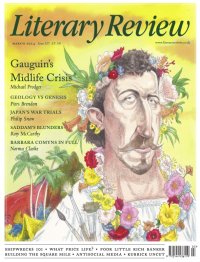Suzi Feay
All the Queen’s Women
The Tower
By Flora Carr
Hutchinson Heinemann 257pp £16.99
Alison Uttley’s novel A Traveller in Time (1939), republished last year, introduced many a dreamy teenager to the story of the imprisoned Mary, Queen of Scots, dethroned, diminished but still, siren-like, able to enchant male followers to their doom. Young Penelope, staying in an English country house that once belonged to the Babingtons, is able to slip back and forth across three hundred years to witness the plot to free the captured queen that takes its name from the family, but not to avert disaster.
Flora Carr picks up the siren motif in her more adult, considerably less ornamental take on an earlier episode in Mary’s troubled history. Its focus is another period of incarceration for Mary, this time at Lochleven Castle in Scotland, a stronghold in the middle of a loch. The timespan of the novel is comparatively small, comprising less than a year. A pregnant Mary arrives with two attendants, the Frenchwoman Marie de Courcelles, always called ‘Cuckoo’, and a young Scot, Jane, through whose eyes we see much of the action. Jane is insecure and of lower status than the ‘jewelled ladies’ (for some reason this is always italicised) who have served Mary hitherto.
There is some jockeying for the position of chief confidante, which both women realise they have lost out on with the dramatic arrival of Lady Seton, Mary’s childhood friend. They are all stuck in a stinking chamber, allowed very little access to open air and forced to endure the blandly

Sign Up to our newsletter
Receive free articles, highlights from the archive, news, details of prizes, and much more.@Lit_Review
Follow Literary Review on Twitter
Twitter Feed
It wasn’t until 1825 that Pepys’s diary became available for the first time. How it was eventually decrypted and published is a story of subterfuge and duplicity.
Kate Loveman tells the tale.
Kate Loveman - Publishing Pepys
Kate Loveman: Publishing Pepys
literaryreview.co.uk
Arthur Christopher Benson was a pillar of the Edwardian establishment. He was supremely well connected. As his newly published diaries reveal, he was also riotously indiscreet.
Piers Brendon compares Benson’s journals to others from the 20th century.
Piers Brendon - Land of Dopes & Tories
Piers Brendon: Land of Dopes & Tories - The Benson Diaries: Selections from the Diary of Arthur Christopher Benson by Eamon Duffy & Ronald Hyam (edd)
literaryreview.co.uk
Of the siblings Gwen and Augustus John, it is Augustus who has commanded most attention from collectors and connoisseurs.
Was he really the finer artist, asks Tanya Harrod, or is it time Gwen emerged from her brother’s shadow?
Tanya Harrod - Cut from the Same Canvas
Tanya Harrod: Cut from the Same Canvas - Artists, Siblings, Visionaries: The Lives and Loves of Gwen and Augustus John by Judith Mackrell
literaryreview.co.uk